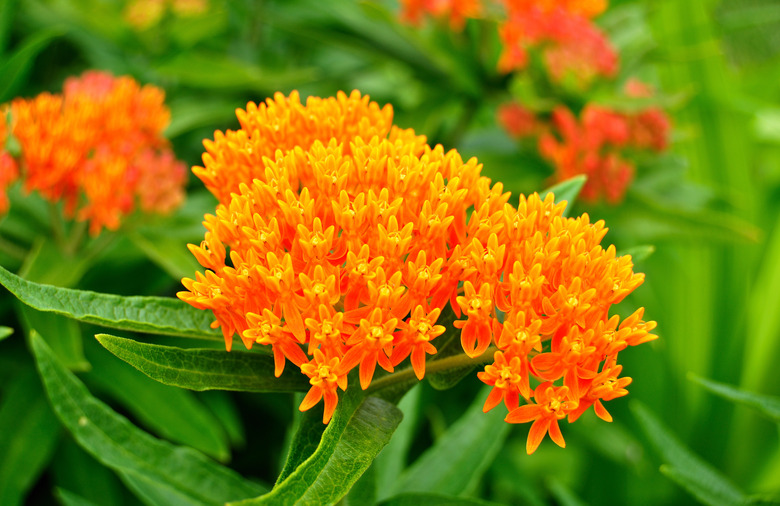All About Milkweed Plants
We may receive a commission on purchases made from links.
Milkweed is an indispensable flowering perennial for any butterfly garden. The leaves of these tough meadow plants are the only food source for monarch butterfly caterpillars, playing an essential role in the life cycle of the imperiled butterfly. The toxins in the Asclepias leaves that caterpillars eat serve as a defense against hungry predators. Plus, the plants provide food and nectar for as many as 450 types of bees, butterflies, moths, and other insects.
While not every garden has space for the more aggressive common milkweed, there are several species of these low-maintenance, sun-loving flowers to consider for your garden. Most are very tolerant of all soils and require little care. When choosing native flowering plants, select a milkweed and you are certain to attract many pollinators to your property.
About Common Milkweed
About Common Milkweed
Common milkweed's single stalks bear large, ovate leaves and two to five balls of pink flower clusters in summer. Asclepias syriaca is native to most of the United States except for parts of the West and Florida. The common milkweed grows 3 to 5 feet, sometimes reaching 8 feet tall. Broken stems and leaves ooze a milky white sap. This striking plant doesn't mind occasional dryness and has deep rhizomes that quickly spread underground to create a colony. Plant it in full sun in an area where you can handle its aggressive growth.
About Butterfly Weed
About Butterfly Weed
Butterfly weed (A. tuberosa) has become a popular garden plant due to its shorter stature, bright orange flowers, and less aggressive nature. This plant is native to most of the United States except for the Northwest. Butterfly weed often stays a more manageable 2 feet tall, with smaller, narrower leaves and is topped with flat umbels of orangeish flowers in late spring and summer.
Butterfly weed is drought-tolerant and will cheerfully bloom in the summer heat. It is easy to find, with nurseries expanding the range of colors with varieties like A. tuberosa 'Hello Yellow' and 'Gay Butterflies,' a mix of orange, red, and yellow flowers. Butterfly weed spreads by seed rather than rhizomes.
About Swamp Milkweed
About Swamp Milkweed
Swamp milkweed, or A. incarnata, is another popular milkweed for moister spots in the garden. This plant is native to most of the United States except for Arizona and the West Coast. Swamp milkweed grows 3 to 5 feet tall with rosey or purpleish-pink flower clusters in summer and early fall. It also has a white sap in its leaves and stems.
Swamp milkweed is more shade-tolerant than other species, usually growing in sunny openings in marshes or along ditches, but it can grow in average soil as long as it doesn't dry out. Swamp milkweed spreads along rhizomes but is better behaved than common milkweed. It's a great choice for growing in a rain garden or in a container.
About Western Milkweeds
About Western Milkweeds
There are many milkweeds native to the Western U.S., but the two most commonly available are narrow-leaved and showy milkweed (A. fascicularis and A. speciosa). These plants prefer full sun but can tolerate light shade. They are drought-tolerant once established but also like moisture, as they tend to grow in areas that flood.
Showy milkweed typically grows 1 1/2 to 3 feet and has spherical balls of white flowers tinged with rosy pink in late spring and summer. Narrow-leaved milkweed, also known as Mexican whorled milkweed, bears multiple clusters of greenish-white flowers tinged with purplish-pink in summer.
About Tropical Milkweed
About Tropical Milkweed
Tropical milkweed (A. curassavica) is a nonnative species of milkweed from the Caribbean that is frequently available at garden centers. The plant remains evergreen in USDA zones 9 to 11, grows 3 to 4 feet tall, and has orange and red flowers. Tropical milkweed grows best in full sun and with regular water. In tropical areas, it will bloom all year. Because this evergreen plant can delay the migration of monarchs and carry pests year-round, experts recommend against planting tropical milkweed in areas where it will overwinter.
How to Grow Milkweed
How to Grow Milkweed
Milkweed plants are very tolerant of many soil types but tend to prefer well-drained soil, with the exception of the moisture-loving swamp milkweed. Transplant milkweed in full sun (preferably in the fall if you live in a warm climate) and water deeply. During dry spells, water once every one to two weeks to get it established. After the first summer, all species other than swamp milkweed only require watering during extreme heat or drought. Milkweed doesn't need to be fertilized.
Insects That Feed on Milkweed
Insects That Feed on Milkweed
If monarch butterflies visit your milkweed patch, you could see hungry caterpillars with yellow, white, and black stripes within days. The caterpillars will leave ragged edges or eat entire leaves off the plants. For that reason, it's best to have many milkweed plants available in a more informal garden. Planting lush greenery around your milkweed can also help hide the damage.
Milkweed can also attract some pests. Predators often keep them in check, but sometimes, unwanted insects, like slugs, oleander aphids, and milkweed leaf beetles, defoliate or otherwise damage the plants. Because you don't want to accidentally harm monarch caterpillars, remove pests manually and drop them into a bucket of soapy water. A strong jet of water from the garden hose can also help reduce the population of pests.
About Milkweed Seeds
About Milkweed Seeds
Milkweeds grow seed pods that burst in the fall, releasing a silky floss that carries seeds in the wind. If you don't want seedlings to sprout up around your garden, remove the pods while they are still green and throw them out. Otherwise, seeds can be collected and planted under a thin layer of soil, where they will overwinter and sprout in the spring.
